(Upload on December 27 2025) [ 日本語 | English ]
Mount Usu / Sarobetsu post-mined peatland
From left: Crater basin in 1986 and 2006. Cottongrass / Daylily
[world, each volcano, volcanic materials (tephra, lava), volcanic geomorphology]
The study of volcanoes, including lava, magma, and their related geological, geophysical and geochemical phenomena. Also, it includes volcano ecology (s.l.).
unstratifled rocks were formed by fusion in fire

Vesvio Volcano, (Rittmann, 1936)
|
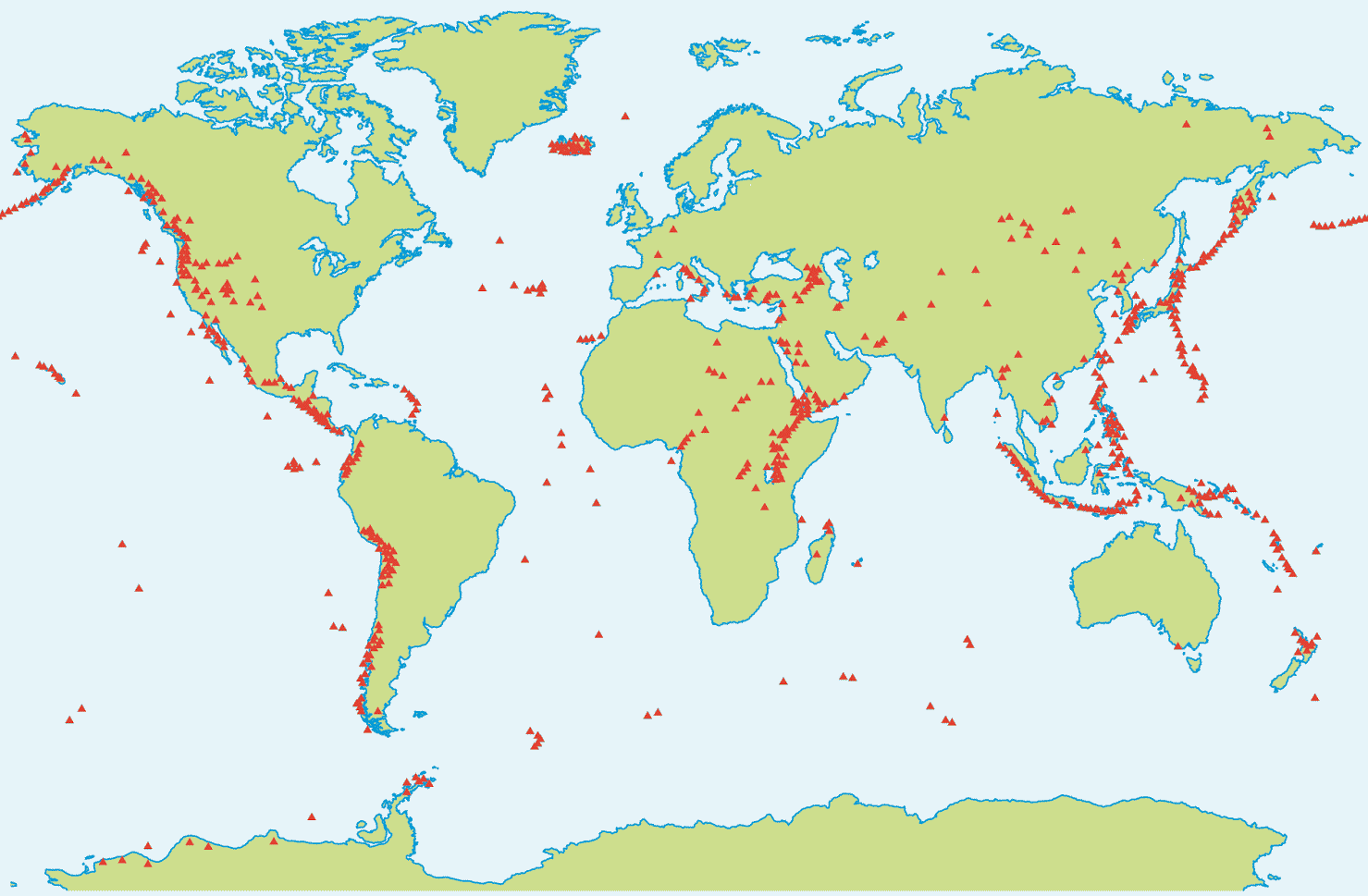 Fig. Distribution of active volcanoes in the world Concentration areas 1. hotspot (e.g., Hawaii) 2. island arc (ark) 3. great rift valley [ volcanoes : the characteristics of eadh volcano or volcanic group] |
Table 2. Classification and characteristic features of volcanic regions in the world based on the plate tectonics model (after Nakamura 1974; Miyashiro 1975; Ui 1975; Fujii 1975).
Volcanic belt (火山帯)= volcanic zone or volcano beltDef. ≈ large volcanically active region Andean Volcanic Belt Garibaldi Volcanic Belt Taupo Volcanic Zone Trans-Mexican Volcanic Belt |
| Volcano type | Region | |||||
| Island arcs and continental margin | Alpine orogenic zone | Intra- continent | Intra- ocean | Rift and mid-oceanic ridge | World | |
| Stratovolcano (+ caldera) | 432 | 19 | 7 | 17 | 29 | 504 |
| Shieldvolcano (+ caldera) | 14 | 6 | 2 | 26 | 50 | 98 |
| Caldera volcano | 47 | 1 | 2 | 1 | 1 | 52 |
| Monogenetic volcano | 22 | 10 | 2 | 3 | 8 | 45 |
| Total | 515 | 36 | 13 | 47 | 88 | 699 |
| Morphologic explosion index | 97 | 77 | 82 | 41 | 38 | 85 |
Magmatic eruption (マグマ性噴火)Phreatomagmatic explosion (マグマ水蒸気爆発)Phreatic explosion (水蒸気爆発) |
Terrestrial volcanoes (陸上火山)0. Defined by the present land formnot considering the factors and mechanisms → dead words1. Named by the previously-erupted, famous volcanoeseasy to understand ↔ various classificationsTable 1. The types of eruptions and the examples. The classical terms derived from the specific volcanoes (Macdonald 1972) modified by the additions of pyroclastic flow and marine eruptions Icelandic (basaltic flood) (Laki 1783, suggesting the volcanic activities on oceanic ridges) Hawaiian (ハワイ式): high fluidity, less-gas lava Hualalai, Kilauea, Lohoi, Mauna Loa (1942), Mahukona, Kahoolawe, Kohala, Mauna Kea, Maui, Oahu Strombolian (ストロンボリ式): basalt, basaltic, andesite, lower viscosity than Hawaiian (relatively low), repeated small explosions with least gasStromboli, Mihara (三原山) Vulcanian (ブルカノ式): large explosions with long period of dormancyVulcano 1888-90 Plinian (プリニー式): alkali laterite, foamed lavaVesuvius AD 79 Eruption accompanying pyroclastic flowNuée ardente
Peleean type (プレー式) - Pelee 1902: lava dome, small-scaled pyroclastic flow
Intermediate type - Asama 1783 Volcanic mudflow (火山泥流) - Kelut 1919 Subaqueous eruption Shallow water: Hydromagmatic - Taal 1965
(occurrence of base-surge)
Sub-glacial - Grimsvotn |
2. Classified by the productions of volcanic smoke, pumice, ect.a) Combined with the sizes of volcanic ejecta, physical properties, etc.Factors defining kinds of volcanic eruptions (Aramaki 1979)
i) Table 6. Types of volcanic eruption as defined by the kind of ejecta. 1. Gas emission from:
a. fumarole, solfatara, etc.
a. hot and cold springs
a. gas + accessory and accidental fragments → phreatic
a. lava lake |
| Quality of magma | Quantity of magma produced | Types of activity | ||||
| Small → | → Great | |||||
| Fluid, very hot, basic ↑ | Individual lava flows (hornitos) | Exogenous domes in flat country | Icelandic type | Hawaiian type | Effusive ↓ | |
| ↑ Viscosity, gas content and silica percentage | Cinder (scoria) cones, with lava flows | Lava flows predominant stratovolcanoes Pyroclastic material predominant | With parasitic cinder cones and lateral lava streams | ↓ ↓ ↓ | ||
| ↓ ↓ ↓ | Loose pyroclastic cones with thick lava flows | Ruptured dome with thick lava flow | Cinder cone with endogenous dome | With parasitic cinder cones and lateral lava streams | Mixed ↓ ↓ | |
| ↓ Viscous, relatively cool, acid | Maare, with thin covering of pyroclasts | Maare with pyroclasitc ring-walls (ramparts) | Craters with ring-wall and covering of pyroclastis | Caldera with covering of pyroclasts | ↓ ↓ Explosive | |
| Extremely viscous with abundant crystals | Gas Maare (diatremes) | Explosion craters | Explosion caldera | Volcano-tectonic sinks | Explosive; gasnous only |
| Quality magma | Quality of magma produced | Type of activity | |
| Very hot and fluid basic | Lava flows from fissures | (Basalt) lava plateau; eruptive fissures mainly covered | Effusive |
| ↓ | Lava flows with banks of scoriae along fissure | (Basalt) lava plateau with rows of cinder cones and banks of scoriae | ↓ |
| Hot, moderately fluid basic | Banks of pyroclasts along fissure; lava flows | Stratovolcanic ridges, with rows of craters | Mixed |
| Viscous, cooler, intermediate | Endogenous (pressure) ridges with banks of scoriae (pumice) | Unknown | ↓ |
| Extremely viscous, with abundant crystals | Explosion trenches with banks of scoriae | Ignimbrite sheets, often with volcano-tectonic sinks | Explosive |
|
Entries used for description of the kind of volcanic activity in the Catalogue of the Active Volcanoes (IAVCEI) (Simkin & Siebert 1994) central crater, parasitic crater, radical fissure, regional fissure, lava lake, crater lake, normal explosion, nuee ardente, lava low, lava dome, spine, solfatara fields (vapors), phreatic explosion, mud eruption, mud flow, subglacial, submarine, islet formation, tidal wave (tsunami) destruction of arable land, casualties
Conventional symbols used in the Catalogue and the Bulletin of Volcanic Eruptions: obtaining generalization by using symbols to express eruption types |
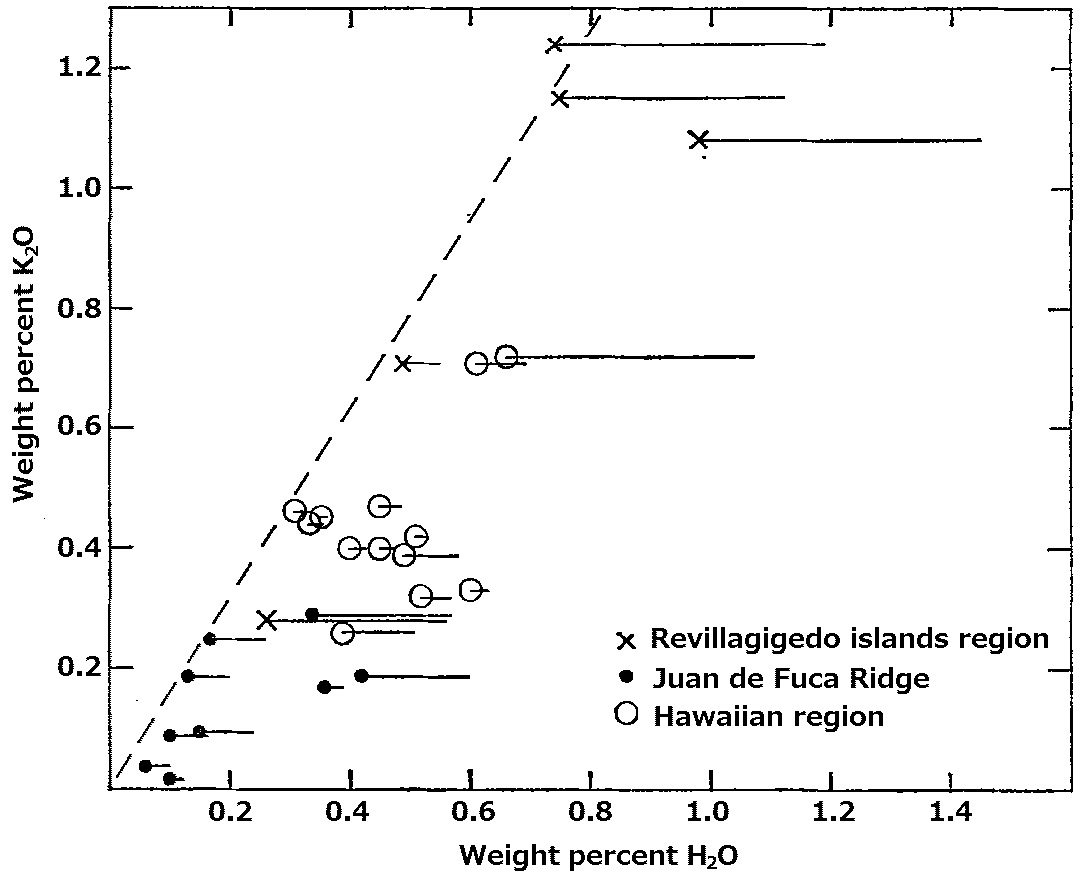
Fig. 2. Water and K2O contents of deep-sea basalts from Hawaiian region. Revillagigedo Islands region, and Juan de Fuca Ridge. Symbols represent H2O+ content and right-hand end of line is total H2O content. (Moore 1970) Marine eruptions rarely occur where the sea depth becomes more than 2000 m. |

Fig. 3. Weight percent of F, Cl, P2O5, and H2O+ in deep-sea basalt from Revillagidedo Islands region, Hawaiian region, and Juan de Fuca Ridge. (Moore 1970) Deep sea volcanismDeep sea basaltic volcanism→ fluidial magma → quiet (minimal lava-water interaction) → massive basalt, pillow lava (similar to pahoehoe) → viscous magma→ hyaloclastic (strong lava-water interaction) → fragmentation and hydration of the lava
→ palagonite grains (smectites) → chemical leaching from lava fragments → Fe-Mn oxides Hydrothermal vent or chimney (熱水噴出孔)= fissures on the seabed from which geothermally heated water discharges Distribution: (1) Mid-Atlantic Ridge province, (2) east Scotia Ridge province, (3) northern East Pacific Rise province, (4) central East Pacific Rise province, (5) southern East Pacific Rise province, (6) south of the Easter Microplate, (7) Indian Ocean province, (8-11) four provinces in the western Pacific and lots more
developing specific ecosystems |
Determined by intensity (強度) and magnitue (規模)Volcanic explosivity index (火山爆発指数), VEIranging from 0 to 8indicating a relative explosiveness of volcanic eruptions, based on volume of products, eruption cloud height, and qualitative observations
Ex. Table IX. Intensity of volcanic activity, classified according to the volume of solid ejecta (Tsuya 1955). Types: A: essentially lava-flows, B: fragmentary ejecta only, D: essentially ejected old detritus. I: intensity. L: limit of volume of volcanic ejecta (km3)
Grade (Scale) Volcano Year Ejecta (km3) Type Volume |
VI (1-0.1) Fujisan, Japan 1707 B 0.8 (Walker 1973) Dispersal index (D, 分散指数)surface area covered by an ash or tephra fall, where the thickness is equal or more than 1/100 of the thickness of the fall at the ventDense-rock equivalent, DREestimating volcanic eruption volume |
Table 5. Estimation of volcanic energies on Japanese and Indonesian volcanoes (Yokoyama 1957) = energy equivalent based on volcanic eruptions
| Volcano | Year | Ejecta volume (cc) | type | Total energy (erg) | log | Scale* volume (cc)** | grade | Activity |
| Tambora | 1985 | 1 × 1017 | B | 8.4 × 1026 | 27 | 1017 | VIII | Ο↑ |
| Sakurajima | 1914 | 2.1 × 1015 | AB | 4.6 × 1025 | 26 | 1016-1015 | VII | Ο-↑≈>⊗ |
| Krakatoa | 1883 | 5 × 1015 | B | < 1025 | 25 | 1016-1015 | VII | ΟΟΟ↑∧ |
| Asama | 1783 | 4.5 × 1014 | AB | 8.8 × 1024 | 25 | 1015-1014 | VI | Ο↑≈>⊗† |
| Fuji | 1707 | 8.5 × 1014 | B | 7.1 × 1024 | 25 | 1015-1014 | VI | ΟΟ↑⊗ |
| Sakurajima | 1946 | 8.3 × 1013 | A | 2.1 × 1024 | 24 | 1014-1013 | V | ΟΟ↑≈> |
| Mihara | 1777-8 | 3.4 × 1013 | A | 1.0 × 1024 | 24 | 1014-1013 | V | Ο↑≈> |
| Torishima | 1939 | 3.1 × 1013 | AB | 9.7 × 1023 | 24 | 1014-1013 | V | Ο↑≈>⊗ |
| Mihara | 1950-1 | 3.0 × 1013 | A | 9.4 × 1023 | 24 | 1014-1013 | V | Ο↑≈> |
| Koma | 1929 | 5.1 × 1013 | B | 5.6 × 1023 | 24 | 1014-1013 | V | Ο↑ |
| Miyakejima | 1940 | 1.9 × 1013 | AB | 4.8 × 1023 | 24 | 1014-1013 | V | ΟΟ≈>↑Ο |
| Bandaisan | 1888 | 1.2 × 1015 | D | < 1023 | 23 | 1016-1015 | VII | Ο↑~>⊗† |
| Guntur | 1843 | 7.8 × 1012 | B | 6.5 ×1022 | 23 | 1013-1012 | IV | Ο↑⊗ |
| Asama | 1935 | 2.2 × 1012 | B | 4.8 × 1022 | 23 | 1013-1012 | IV | Ο↑ |
| Pematang Bata | 1933 | 2.1 × 1011 | D | 4.5 × 1022 | 23 | 1015-1014 | VI | ↑ |
| Una Una | 1898 | 2.2 × 1012 | B | 1.8 × 1022 | 22 | 1013-1012 | VI | ↑~>⊗ |
| Mihara | 1954 | 4 × 1011 | A | 1.3 × 1022 | 22 | 1012-1011 | III | Ο↑≈> |
| Adatara | 1900 | 1.1 × 1012 | B | 6.4 ×1021 | 22 | 1013-1012 | IV | Ο↑↑ |
| Asama | 1938 | 1.5 × 1011 | B | 4.0 × 1021 | 22 | 1012-1011 | III | Ο↑ |
| Azuma | 1893 | 5 × 1011 | B | < 1021 | 21 | 1012-1011 | III | Ο↑† |
| Mihara | 1912 | 2 × 1010 | A | 6.3 × 1020 | 21 | 1011-1010 | II | Ο↑≈> |
| Tokachi | 1926 | 2.7 × 1010 | DB | 2.8 × 1020 | 20 | 1013-1012 | IV | Ο↑~>⊗† |
| Myoozin reef | 1952 | ? | B | < 1019 | 19 | ? | ? | ∧↑↑ |
| Kusatsu-Shirane | 1932 | 1.6 × 1010 | D | 1.6 × 1018 | 18 | 1011-1010 | II | Ο↑ |
Types of ejecta: A, essential lavaflow. B, fragmentary ejecta only. D, essentially ejected old detritus. *: Tsuya's intensity scale. **: volume of ejecta
1. volcanic gas (火山ガス)Table 1.1. Classification of volcanic gas based on the temperature of fumaroles (Iwasaki, et al. 1966)
Type: temperature __ °C __ chemical components except water vapor 2. lava (溶岩)molten rock (magma) formed of basalt, andesite, dacite, or rhyolite, rocks (in order of increasing silicate content)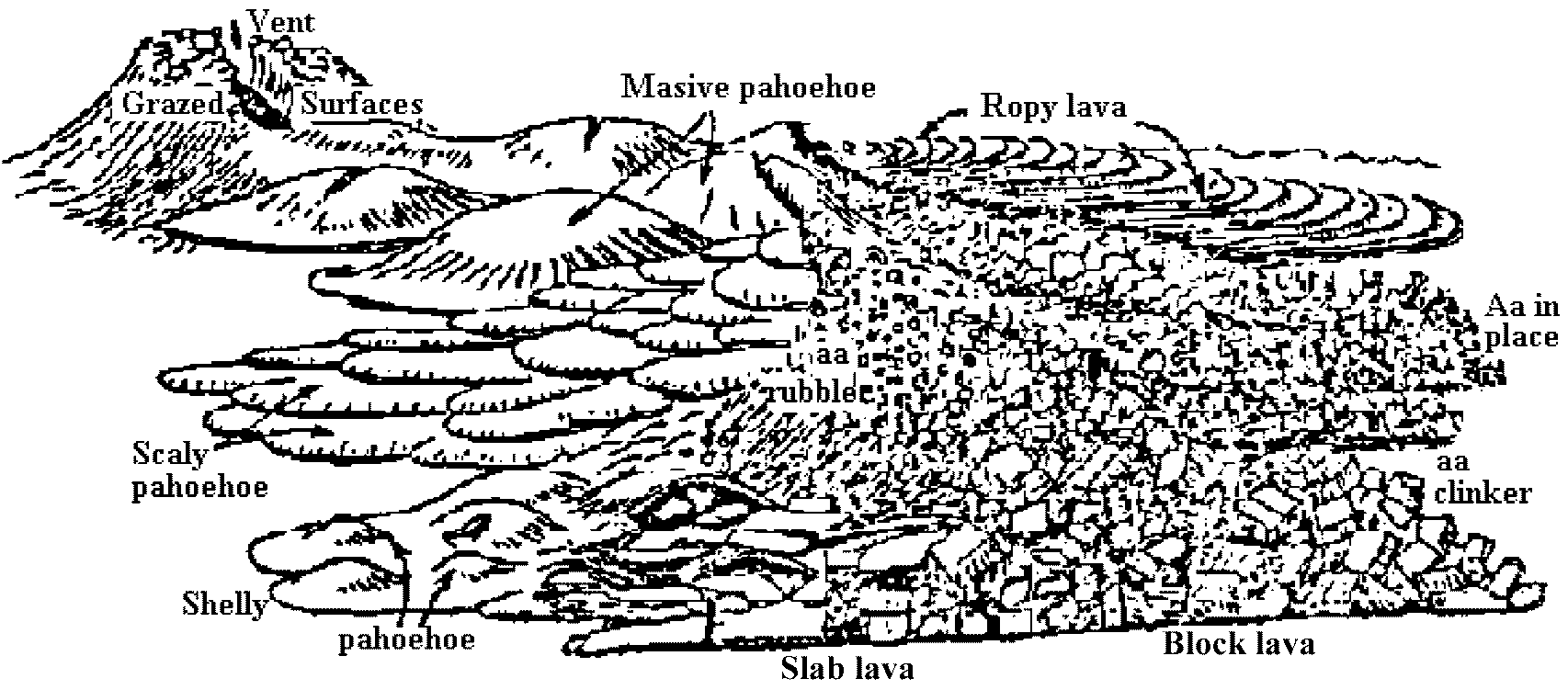 Fig. 301. Idealized diagram illustrating the classification of lava surfaces (Jones 1943) a. Pahoehoe lava (パホイホイ溶岩)= ropy lava (縄状溶岩)basalt forming smooth, glossy surfaces; low in silicates Pahoehoe lava flows of 1777-78 on Mount Mihara  The lava flows are from the major eruption of the An’ei Era (1777-92). The “Great An’ei Eruption” began at the summit crater and spewed lava fountains forming a cinder cone named Mt. Mihara. It was formed by the accumulation of cinders or scoria (frothy basalt rock full of small gas bubbles). Following the summit eruption, outbreaks occurred in the area to the northwest of Mt. Mihara. This type of lava is called pahoehoe, characterized by smoothly rounded, rippled, or ropy looking surfaces. The lava is typically low in viscosity to form pahoehoe. (2023-06-07)
The lava flows are from the major eruption of the An’ei Era (1777-92). The “Great An’ei Eruption” began at the summit crater and spewed lava fountains forming a cinder cone named Mt. Mihara. It was formed by the accumulation of cinders or scoria (frothy basalt rock full of small gas bubbles). Following the summit eruption, outbreaks occurred in the area to the northwest of Mt. Mihara. This type of lava is called pahoehoe, characterized by smoothly rounded, rippled, or ropy looking surfaces. The lava is typically low in viscosity to form pahoehoe. (2023-06-07)
b. A'a lava (or Aa) (アア溶岩)basalt forming a jumble of irregular cinder blocks; low in silicatesc. Block lava (塊状溶岩)formed of large, smooth-sided blocks; may form domes; usually andesiticEx. Sakurajima (桜島) 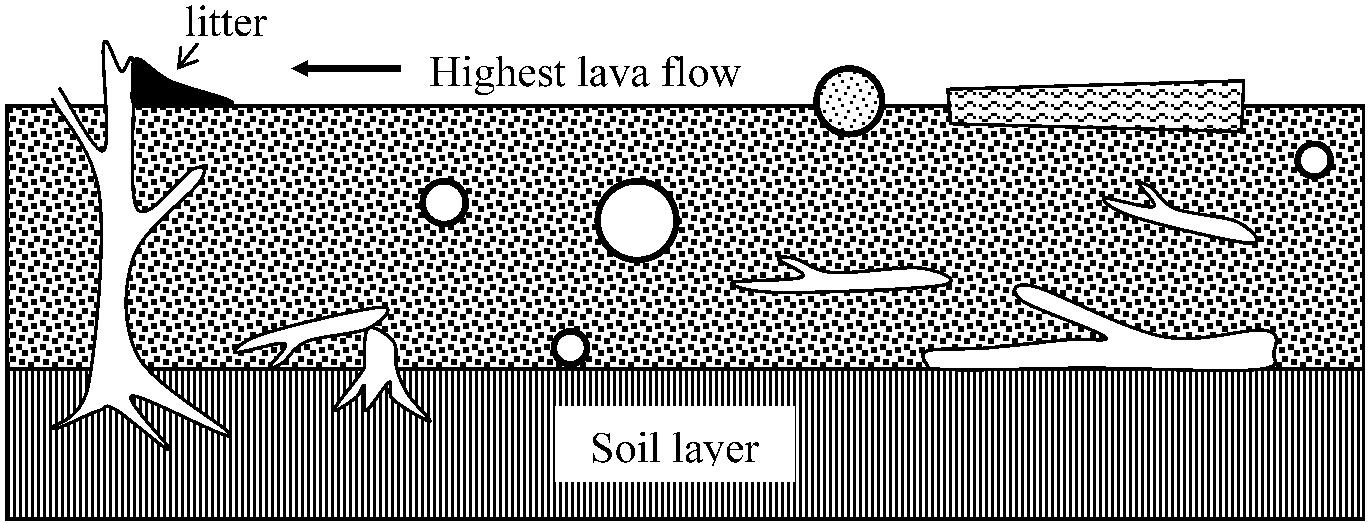 Fig. 355. Diagram showing features produced by a lava flow overwhelming a forest. Underwater lava (水中溶岩)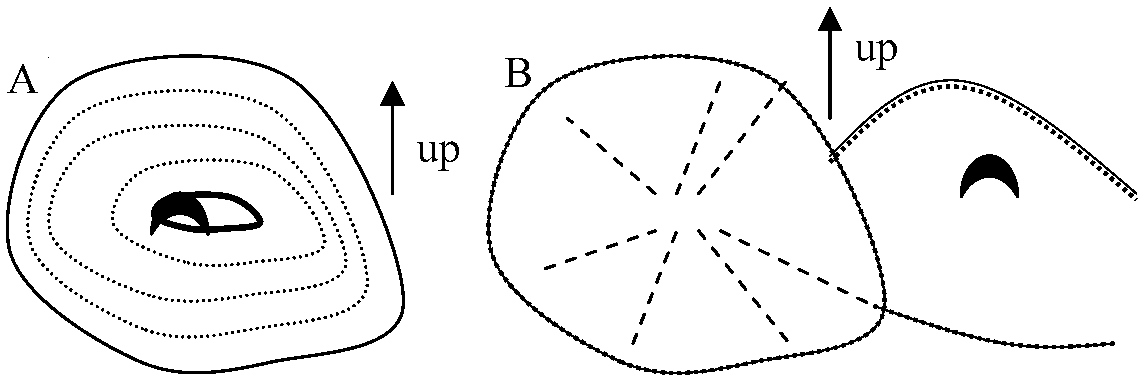 Fig. 5.6. Diagrammatic cross section of a mass of pahoehoe toes (A) and pillow lava (B), showing characteristic structures. The dashed lines represent the inner margin of the glassy skin on the pillows, the stippled areas represent sedimentary material filling interstices between the pillows, and the black areas are open spaces. (Macdonald 1967) 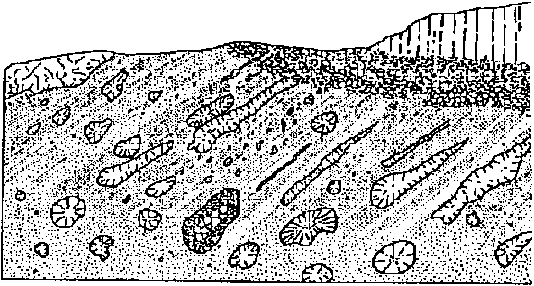 Fig. 5.8. Cross section of a hyaloclasite flow formed in a lake in the Columbia River Plain of Oregon, showing bedding of the hyaloclasite and elongated pillow. (Macdonald 1972) |
d. Domes (円頂丘)viscous intrusions found in craters, commonly of dacite or rhyolite A. Bulbous type________________B. Linear type Fig. 323. Diagrams showing formation of "squeeze-ups". A. Bulbous squeeze-ups formed by successive extrusion of lava. When a bulbous mass is sealed off, the lava escape along one of the sides and forms another. B. Linear squeeze-ups formed along cracks in the crust of a flow. Squeeze-ups are small surface features generally less than a meter in height.
3. Pyroclastic materials (火山砕屑物)Table 1. Definitions of major types of volcanic materials. Materials which have little direct impact on volcanic succession (火山遷移) are not listed. (Francis 1993).
1. Gas A. streaming → free atmospheric dispersal 2. Gas + solid (-liquid) particlesA. streaming (jet)
→ free fall (± wind) B. propulsion by gas explosion
→ free fall (± wind) B. gravity slope movement (talus, slop deposit) 4. Water + solid particlesA. gravity flow (mud flow, flood, subaqueous sedimentation) |
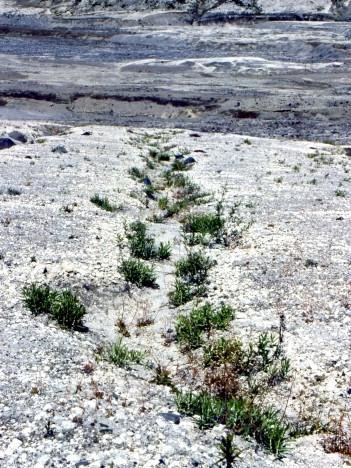
All air-fall pyroclastic materials produced by volcanic eruptions
An example on the classification of tephra by particle size (mm in diameter)
Ash: < 2 (or 4)
Lapilli (volcanic cinders): 2 to 64 (or 4 to 32)
Volcanic blocks: > 64 (or > 32)
→ soil (土壌), tephra in Hokkaido (in JPN)
Molten rock expelled from volcanoes during eruptions
A moving outpouring of lava, created during a non-explosive effusive eruption
Mishima lava (三島溶岩), lava flow on Rangitoto Island in NZ
|
↑ Weak loose structure to solid structure ↓ |
Glazed surfaces found inside caves, and vents along with drip pendants and flow-lines | Massive pahoehoe of very thick cross-section (10 + feet) with hummocks or tumuli, and with cracks at infrequent intervals | Ropy lava (on surfaces, slabs and blocks) fine smooth ropes to coarse rough ropes (1 to 6 inches) formed by folding of viscous surfaces due to the drag of underlying mobile lava (grades to furroughed aa) |
| Scaly pahoehoe thin (one-quarter to one foot) small flow-units overlapping like scales, but solid, may show pillows and toes |
Aa-lava in place
Fine-aa: 0.1 to 1 cm, < 1/2 inch |
||
| Shelly pahoehoe thin bubbles of weak structure (one half foot) that break into slabs and plates of loose structure = slab-lava | Aa-rubble of fragmental scoriaceous character, few fractured surfaces (grades from bubble to aa-clinker) | ||
| Block-lava usually four to five fractured sides (grades in size from one-half foot to 10 + feet) |
|
the branch of geomorphology focusing on the study of landforms and features created by volcanic activity
investigating how processes such as eruptions, lava flows, ash deposits and volcanic gas emissions shape the earth surface, both during and after volcanic events  1961 Rittman
1961 Rittman
Geological fissure eruption - ex. Iceland
d > h → dome |
Lava topography (溶岩地形)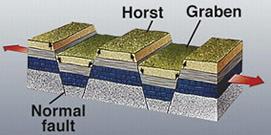 Graben and Horst |
|
|